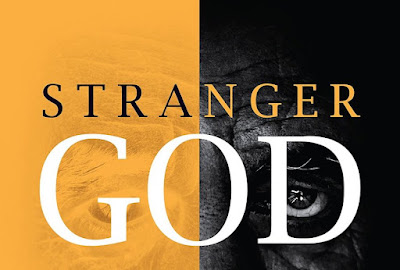In Story of a Soul Thérèse mainly shares stories about how she practices her "little way." She doesn't provide a step-by-step account of how to put her "little way" into practice across contexts and situations, which is something we'd need if we wanted to teach and share the Little Way in a spiritual formation curriculum. I've had classes in spiritual formation read Story of a Soul, and frankly, they often can't make heads or tails of it.
Facing this, in Stranger God I attempt to "extract" from Thérèse's stories three practices that can help us "practice Jesus" in everyday life. The practices I describe in Stranger God were selected with radical hospitality in mind, forming us, in the language of Stranger God, to welcome the God who comes to us "in disguise," as we see in Matthew 25, Jesus coming to us in the homeless, hungry, and incarcerated. These Little Way practices I describe as Seeing, Stopping, and Approaching.
Again, you won't see these practices---Seeing, Stopping, and Approaching--in Story of a Soul. Nor was Thérèse telling stories about walking the streets of her city talking with the homeless. But what we do find in Story of a Soul is a posture of intentionality in moving through social spaces. The practices I describe as Seeing, Stopping, and Approaching in Stranger God are inspired by specific stories in Story of a Soul, and they try to capture Thérèse's intentionality and package it in practices that are transferable across social contexts. The goal was is to make the Little Way less inspirational and sentimental and more practical and teachable. If you want the Little Way to become a spiritual discipline you need to be able to coach it.
The practice of Seeing I describe in Stranger God is simply a posture of social mindfulness. The practice of Seeing is paying attention to--seeing, really seeing--the person right in front of you. We observe Thérèse practicing Seeing as she notices the sisters in her convent who were socially marginalized and lonely. Older translations of the Bible use the word "Behold" a lot. "Beholding" is deeper than mere "looking." You can look, but not behold. The practice of Seeing is a practice of beholding others. Consider the failure of the Rich Man in the parable with the poor man Lazarus. Lazarus sits at the Rich Man's gate begging, sores covering his body which the dogs came and licked. Though sitting at his very door, the Rich Man never sees Lazarus, never beholds him. Most of our failures to welcome others begin and end with these failures of beholding. Practices of Seeing try to bring people into view.
The practice Stopping is a variant of of the practice of Seeing. We often don't see people because of the pace of our lives, our hurry and preoccupations. We have agendas and stuff to get done. Consequently, we tend to blow right past people. The practice of Stopping is a practice of slowing and becoming interruptible. We see this in Thérèse's stories of not detouring around sisters in her convent, allowing the chance meeting of a sister to interrupt her.
Finally, the practice of Approaching is moving toward others, getting out of our social groove and comfort zone. We see this in Thérèse's story of moving toward disagreeable sisters during her free time. The goal here, I point out to audiences, isn't to seek out the most toxic person you can find. The practice of Approaching is, rather, changing social locations, moving toward others rather than away. In my estimation, the practice of Approaching is the most potent of the practices I describe in Stranger God in overcoming what David Leong calls "the social logic of homogeneity." Socially, we are attracted to the same and similar. Like is naturally attracted to like. Conversely, we avoid and step away from the dissimilar and the different. The only way to overcome this wired in social tendency--how strangeness makes us wary--is by adopting an intentional practice of Approaching, stepping away from social sameness into social difference. Practices of Approaching are what led me to the poor, disabled, and incarcerated in my city. Inspired by the Little Way, I became intentional about stepping away from people with PhDs on a college campus (my natural affinity group) toward people in very different social locations. That intentionality, practices of Approaching, has made all the difference.


